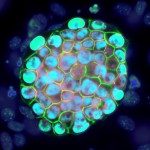Link to Pubmed [PMID] – 8625802
Development 1996 Feb;122(2):509-20
The Sox gene family consists of a large number of embryonically expressed genes related via the possession of a 79-amino-acid DNA-binding domain known as the HMG box. Partial clones for the first three Sox genes (al-a3) were isolated by homology to the HMG box of the testis-determining gene Sry and are now termed Sox-1, Sox-2 and Sox-3, Sox-3 is highly conserved amongst mammalian species and is located on the X chromosome. This has led to the proposal that Sry evolved from Sox-3. We present the cloning and sequencing of Sox-1, Sox-2 and Sox-3 from the mouse and show that Sox-3 is most closely relate to Sry. We also confirm that mouse Sox-3 is located on the X chromosome between Hprt and Dmd. Analysis of the distribution of Sox-3 RNA shows that its main site of expression is in the developing central nervous system, suggesting a role for Sox-3 in neural development. Moreover, we demonstrate that Sox-3, as well as Sox-1 and Sox-2, are expressed in the urogenital ridge and that their protein products are able to bind the same DNA sequence motif as Sry in vitro, but with different affinities. These observations prompt discussion of an evolutionary link between the genes and support the model that Sry has evolved from Sox-3. However our findings imply that if this is true, then Sry has undergone concomitant changes resulting in loss of CNS expression and altered DNA-binding properties.

